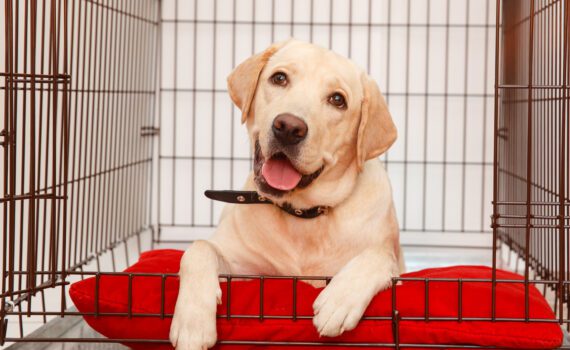
Your Dog’s Friendly Space
One of the most controversial pieces of dog equipment is the humble crate. Some people love them and some people hate them. These metal, plastic, or material structures often arouse strong feelings in dog owners’ minds. Personal disclosure, I use dog crates and highly recommend them to my puppy buyers. It has been eye-opening to gauge their reactions which range from, “I would never confine my dog to jail,” to “I couldn’t live without one!”. Here’s why I like crates and so will you and your dog if you follow these easy suggestions.
Primal Instinct
First, realize that dogs are denning animals. They feel safe and relaxed in a small, enclosed space of their own, a den. So far from feeling imprisoned, your dog will enjoy having his/her own special spot. If you are beginning crate training with a puppy expect some whines and cries for the first few nights away from their littermates and Mom. This is normal and can be reduced if you move the crate into your bedroom and stroke the puppy and quietly talk to it during those first few nights on its own. A ticking clock reminds them of their mother’s heartbeat and a plush toy can simulate a littermate while some soft music can be soothing. A treat upon entering the crate is always a good idea as the pup begins to associate the crate with good things and helps keep the puppy relaxed. Try our Single Ingredient Treats, Frozen Necks, or even our Raw Meaty Bones to chew on.
How To Introduce Your Dog to a Crate
If you are introducing an older dog to a crate it may be more challenging. Especially if the older dog has had previous bad experiences with crates. Being left too long in a crate, not having appropriate food or water while in a crate, being too hot or cold in a crate, or been socially isolated in a crate are all triggers. All of those scenarios must be prevented from happening if you wish to have a healthy dog/owner/crate relationship. But older dogs can learn new tricks and they can also learn to adjust to time in a crate. Just remember that behavior modification requires patience. Crate manufacturers recommend tossing treats into the crate and leaving the door open until your dog feels safe inside. Staying present as you begin closing the door for short periods and reassuring your dog with praise when it remains calm is also helpful. It’s always baby steps, but each step brings you closer to the goal of a dog who is comfortable in his/her own secure space.
Just remember that you really cannot rush that goal. If you have made the crate comfortable with a soft blanket, toys, a spill-proof water dish, and some treats your dog will eventually want to spend time there. This is important if you have a dog that cannot be left unattended. Dogs who become destructive when alone or ones suffering from incontinence would be good candidates for a limited time in their own crates. Nowadays with many people working from home, it is convenient to occasionally confine your dog to its’ crate during important calls. And if fragile Granny comes for a visit, your boisterous puppy might be more popular if after greeting Granny he can be put in his crate with a yummy treat.
Size Matters
Be sure to get the correct size crate for your dog. It should be large enough to sit, stand and lie down in with a few inches of extra room. Metal crates often come with dividers so that the crate can be shortened when the puppy is small and the dividers moved as the puppy grows larger. This helps prevent elimination accidents in a far corner of a too large crate.
Place Matters
Many pet owners have 2 crates. One set up where the family usually congregates (family room, living room, kitchen) and another set up in a bedroom. Since dogs are pack animals they should not be isolated from their pack (you and your family). Chose the crate location wisely, avoiding drafty areas or nearby heat sources such as sunny windows or heat vents. Multiple dog households, such as mine, often feed their dogs in crates to circumvent food guarding and jealousy issues. This works surprisingly well for crates placed near the kitchen and helps contain food mess.
Crates are a convenient tool. Crates are not a substitute for training and should never be used as punishment. But occupied by your dog for a limited time, kept near the family, and made comfortable, your pet should happily adjust to its’ own cozy little home within your big home.
By Carol Kendig